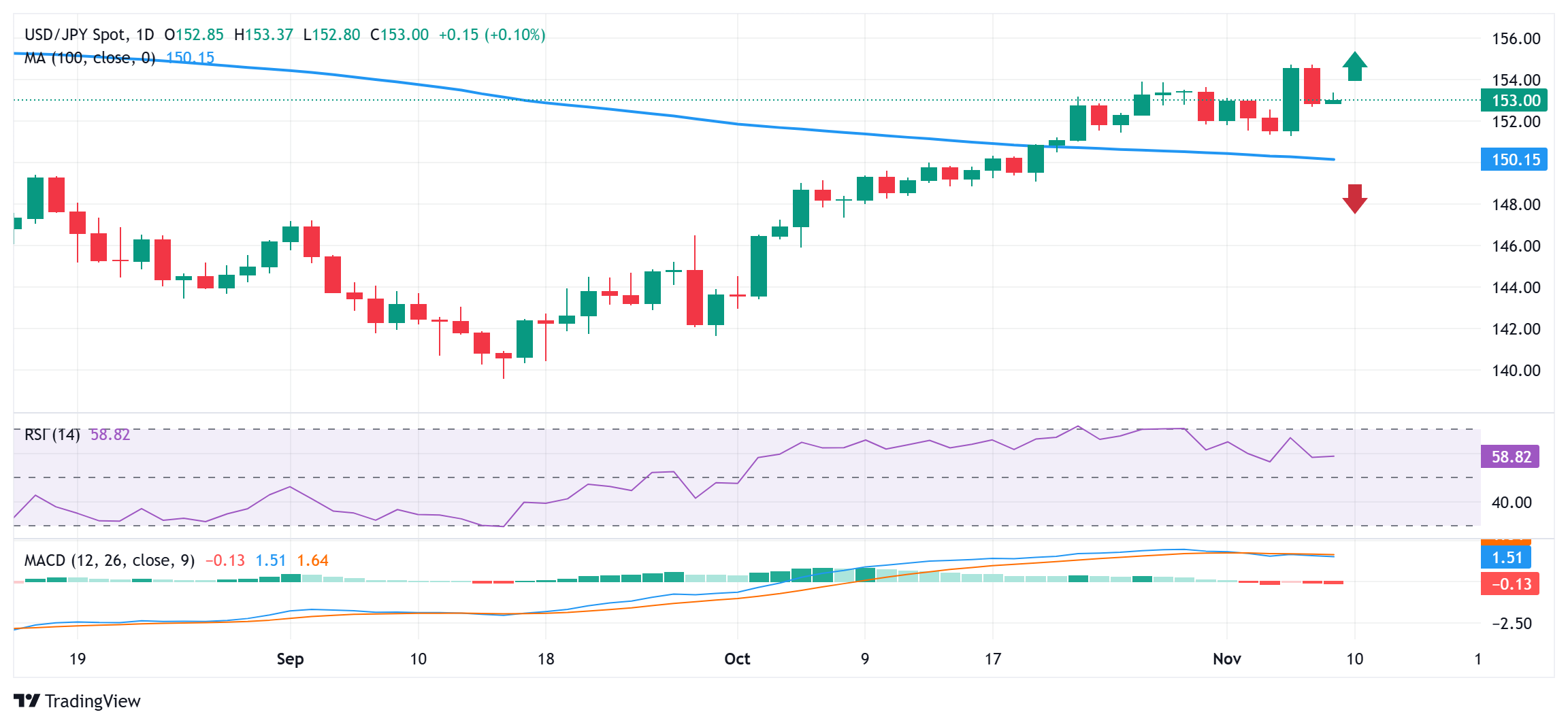Japanese Yen ticks lower against USD, intervention fears help limit losses
- The Japanese Yen struggles to capitalize on Thursday’s recovery from a multi-month trough.
- The BoJ rate-hike uncertainty and the risk-on mood seem to undermine the safe-haven JPY.
- A modest USD uptick offers support to USD/JPY, though intervention fears cap the upside.
The Japanese Yen (JPY) edges lower against its American counterpart during the Asian session on Friday and stalls the previous day's recovery move from the lowest level since July 30. Data released on Thursday showed Japan’s real wages declined in September, which, along with cost-of-living woes, continue to adversely affect household spending and could dampen the inflation outlook. This is expected to delay the Bank of Japan's (BoJ) plans for additional rate hikes amid the domestic political uncertainty and is seen undermining the JPY.
Apart from this, a generally positive risk tone undermines the safe-haven JPY, which, along with the emergence of US Dollar (USD) dip-buying, offers support to the USD/JPY pair. That said, the recent bout of JPY weakness has prompted some verbal intervention from Japanese authorities. Moreover, the unwinding of the Trump trade and the lack of any hawkish signals from the Federal Reserve (Fed) act as a headwind for the US Treasury bond yields. This might hold back the JPY bears from placing aggressive bets and cap the currency pair.
Japanese Yen is weighed down by diminishing odds for another BoJ rate hike in 2024
- Government data released this Friday showed that Japan's household spending fell for the second successive month, by 1.3% in September and 1.1% from the year earlier.
- This comes on top of a fall in Japan's inflation-adjusted wages for the second straight month in September and could hinder the Bank of Japan's plans to hike rates further.
- Donald Trump’s victory in the US presidential election pushed the USD/JPY pair beyond the 154.00 mark on Wednesday and prompted verbal intervention by authorities.
- Japan's Chief Cabinet Secretary, Yoshimasa Hayashi, reiterated that the government intended to closely watch moves in the FX market with a higher sense of urgency.
- Japan’s Vice Finance Minister for International Affairs and top FX official Atsushi Mimura said that the government is ready to take appropriate actions against excessive FX moves.
- Quarterly data from the Ministry of Finance (MOF) showed this Friday that Japan spent ¥5.53 trillion on currency intervention made during the period from June 27 through July 29.
- The US Dollar attracts some dip-buying on Friday to reverse a part of Thursday's pullback from a four-month top and offer some support to the USD/JPY pair.
- The Federal Reserve lowered borrowing costs by 25 basis points on Thursday, following a jumbo rate cut in September that kicked off the policy easing cycle.
- In the post-meeting press conference, Fed Chair Jerome Powell failed to offer any cues that the central bank was likely to pause rate cuts in the near term.
- According to the CME Group's FedWatch Tool, market participants are now pricing in 75% odds the US central bank will cut interest rates again in December.
- Furthermore, traders continue to unwind some of the profitable Trump trades, which might cap any meaningful upside for the USD and the currency pair.
Technical Outlook: USD/JPY needs to move back above 153.50 for bulls to retain control

From a technical perspective, the overnight downfall stalled near the 152.70-152.65 horizontal support. The said area might now act as a pivotal point, below which the USD/JPY pair could accelerate the corrective decline towards the 152.00 mark en route to the 100-day Simple Moving Average (SMA), around the 151.70-151.65 region. Some follow-through selling will suggest that the recent strong move up from the September monthly swing low has run out of steam and paves the way for deeper losses.
On the flip side, the 153.50 area could act as an immediate hurdle ahead of the 153.85-153.90 supply zone. A subsequent move back above the 154.00 mark has the potential to lift the USD/JPY pair back towards the multi-month peak, around the 154.70 region touched on Thursday. The momentum could extend further toward the 155.00 psychological mark and the 155.20 zone (July 30 swing high).
Japanese Yen FAQs
The Japanese Yen (JPY) is one of the world’s most traded currencies. Its value is broadly determined by the performance of the Japanese economy, but more specifically by the Bank of Japan’s policy, the differential between Japanese and US bond yields, or risk sentiment among traders, among other factors.
One of the Bank of Japan’s mandates is currency control, so its moves are key for the Yen. The BoJ has directly intervened in currency markets sometimes, generally to lower the value of the Yen, although it refrains from doing it often due to political concerns of its main trading partners. The BoJ ultra-loose monetary policy between 2013 and 2024 caused the Yen to depreciate against its main currency peers due to an increasing policy divergence between the Bank of Japan and other main central banks. More recently, the gradually unwinding of this ultra-loose policy has given some support to the Yen.
Over the last decade, the BoJ’s stance of sticking to ultra-loose monetary policy has led to a widening policy divergence with other central banks, particularly with the US Federal Reserve. This supported a widening of the differential between the 10-year US and Japanese bonds, which favored the US Dollar against the Japanese Yen. The BoJ decision in 2024 to gradually abandon the ultra-loose policy, coupled with interest-rate cuts in other major central banks, is narrowing this differential.
The Japanese Yen is often seen as a safe-haven investment. This means that in times of market stress, investors are more likely to put their money in the Japanese currency due to its supposed reliability and stability. Turbulent times are likely to strengthen the Yen’s value against other currencies seen as more risky to invest in.
